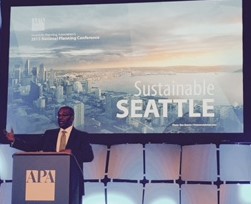- About Us
- Events & Training
- Professional Development
- Sponsorship
- Get Involved
- Resources
Planning - The Art of Responsible Creativity in a Data-Driven WorldBy Chris Comeau, AICP, CTP
Outgoing American Planning Association (APA) National President William Andersen, FAICP, welcomed us to “Sustainable Seattle” APA’s 2015 National Conference. He read an excerpt from the “web of life” quote attributed to Chief Sealth, the Duwamish leader for whom Seattle is named after, then pointed out that sustainability is a major focus in the Pacific Northwest, or Cascadia, which stretches from Vancouver, British Columbia to Eugene, Oregon. Mr. Andersen acknowledged the increasing role and influence of technology and data in the planning profession, but warned of over-reliance on objective numbers, metrics, and data-driven decision making. He urged planners not to forget the ‘art of planning,’ which also examines the soft, subjective, and subtle variables at issue and seeks to apply creative solutions to planning problems. President Andersen then introduced a man who has helped both Seattle and the Cascadia region to gain a world-wide reputation as “Sustainable” – the honorable and inspirational Mr. Ron Sims – whose relevant experiences and accolades are too lengthy to list here.
Mr. Sims began by thanking us for what we do. He said that “Planning is critical,” but that he hadn’t fully appreciated what planners do until he became the King County Executive and consulted his planners every day. He shared a story of visiting Florence, Italy, becoming captivated by Michelangelo’s statue of David, and the power of art, sculpture, and creativity. “Planners are the sculptors of communities” he said, applying their creativity to solve broad problems affecting various disciplines across the spectrum of municipal interests. He also acknowledged that data was important and pointed out that it can tell us what we do, and don’t, want to know. He shared an eye-opening experience demonstrating that the built environment affects the human environment and he came to learn that what we do as planners’ affects people at the genetic level. As King County Executive, he had been confronted with the reality that people in low-income neighborhoods had higher rates of physical illness and shorter life spans that could be correlated to the lack of infrastructure promoting physical activity. At the time, none of King County’s 127 miles of paved bicycle paths passed through low-income neighborhoods, which discouraged them from walking, biking, and being active. "If you want people to walk," said Mr. Sims, "then build a walkable community – design matters at the neighborhood level." Mr. Sims concluded that it is the work of planners that will define the success of this great country because what we do affects people’s lives, including the lives of future generations. In an inspirational crescendo, Mr. Sims directed us in no uncertain terms “Your mission is to make life better for people: It’s all on you planners! You have the skills to make a real difference and you are the ignition key to start the engine of bettering communities! Your work is not done, there is much more to do ……. Planners, you have PURPOSE.”
|



